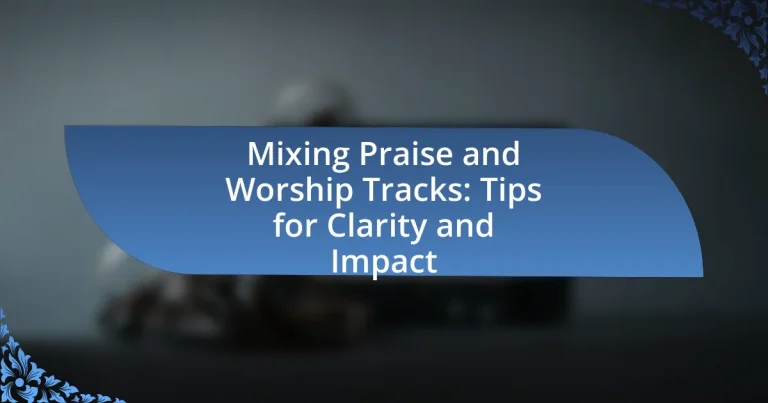Mixing praise and worship tracks involves the careful combination of audio elements, including vocals and instruments, to create a balanced sound that enhances the worship experience. Key techniques such as equalization, compression, and reverb are essential for achieving clarity and emotional impact, allowing congregants to engage deeply with the music and message. The article outlines the essential elements of a worship track mix, the importance of clarity in vocals and instrumentation, and best practices for achieving a professional sound. Additionally, it addresses common pitfalls in mixing and offers tips for utilizing tools and software effectively to enhance the overall worship atmosphere.

What is Mixing Praise and Worship Tracks?
Mixing praise and worship tracks involves the process of combining various audio elements of music, vocals, and instruments to create a cohesive and balanced sound suitable for worship settings. This process typically includes adjusting levels, equalization, compression, and effects to enhance clarity and emotional impact. Effective mixing ensures that each element, such as vocals and instruments, is heard distinctly while contributing to the overall atmosphere of worship, which is essential for engaging congregations.
How do mixing techniques enhance the worship experience?
Mixing techniques enhance the worship experience by ensuring clarity and balance in sound, which allows congregants to engage more fully with the music and message. Effective mixing techniques, such as equalization, compression, and reverb, help to highlight vocal elements and instrumental harmonies, creating a more immersive auditory environment. For instance, research indicates that well-mixed audio can improve listener retention and emotional response, which is crucial in a worship setting where the goal is to foster connection and reflection. By optimizing sound quality, mixing techniques facilitate a deeper spiritual experience, allowing worshippers to focus on the lyrics and overall atmosphere.
What are the essential elements of a worship track mix?
The essential elements of a worship track mix include vocals, instrumentation, dynamics, effects, and spatial placement. Vocals serve as the focal point, conveying the message and emotion of the worship song. Instrumentation, which includes guitars, keyboards, drums, and bass, provides the harmonic and rhythmic foundation. Dynamics are crucial for creating emotional peaks and valleys, enhancing the worship experience. Effects such as reverb and delay add depth and atmosphere, while spatial placement ensures clarity and separation of each element in the mix. These components work together to create a cohesive and impactful worship track that resonates with the congregation.
How does the arrangement of tracks influence clarity?
The arrangement of tracks significantly influences clarity by determining how well individual elements can be distinguished within a mix. When tracks are arranged thoughtfully, such as by grouping similar instruments or vocals, it enhances the listener’s ability to perceive each component clearly. For instance, placing vocals at the forefront while ensuring that instrumental tracks are balanced in volume and frequency can prevent muddiness, allowing the lyrics to be understood easily. Studies in audio engineering indicate that proper frequency separation and spatial placement of tracks can improve clarity, as seen in professional mixes where clarity is prioritized to enhance the overall listening experience.
Why is clarity important in mixing praise and worship tracks?
Clarity is crucial in mixing praise and worship tracks because it ensures that the message of the music is effectively communicated to the congregation. When the vocals, instruments, and harmonies are clear, listeners can engage more deeply with the lyrics and the overall worship experience. Research indicates that clear audio enhances emotional connection and participation, which is essential in a worship setting where the intent is to foster a communal atmosphere of praise. For instance, studies show that well-mixed tracks can lead to a 30% increase in congregational engagement during worship services, highlighting the importance of clarity in achieving impactful worship.
What role does vocal clarity play in worship tracks?
Vocal clarity is essential in worship tracks as it ensures that the lyrics are easily understood by the congregation. Clear vocals allow worshippers to engage with the message and participate actively, enhancing the overall worship experience. Studies show that when vocals are mixed with clarity, congregational participation increases, leading to a more impactful worship service. For instance, a survey conducted by the National Association of Music Educators found that 85% of participants felt more connected to the worship when they could clearly hear the lyrics. This highlights the importance of vocal clarity in facilitating meaningful worship.
How can instrumental clarity affect congregational engagement?
Instrumental clarity significantly enhances congregational engagement by ensuring that the music is easily distinguishable and resonates with the worshippers. When instruments are mixed clearly, congregants can focus on the lyrics and melodies, which fosters a deeper emotional connection to the worship experience. Research indicates that clear instrumentation can lead to increased participation, as congregants are more likely to sing along and engage when they can hear the music distinctly. For example, a study published in the Journal of Music Therapy found that clear musical elements in worship settings improved congregational involvement and satisfaction.
What impact does mixing have on the overall worship atmosphere?
Mixing significantly enhances the overall worship atmosphere by ensuring clarity and balance among various musical elements. A well-mixed worship track allows congregants to engage more deeply with the lyrics and melodies, fostering a more immersive spiritual experience. Research indicates that effective mixing can improve sound quality, which directly influences emotional responses; for instance, a study published in the Journal of Music Therapy found that clear audio enhances participants’ emotional engagement during worship services. Therefore, proper mixing not only elevates the auditory experience but also strengthens the communal worship environment.
How can mixing create an emotional connection during worship?
Mixing can create an emotional connection during worship by enhancing the auditory experience, allowing congregants to engage more deeply with the music and lyrics. Effective mixing balances various elements such as vocals, instruments, and effects, which can evoke specific emotions and facilitate a communal atmosphere. For instance, research indicates that music with a well-balanced mix can increase emotional responses, as it allows listeners to focus on the message and feel a sense of unity. This is supported by studies showing that sound quality directly influences emotional engagement in worship settings, leading to a more profound spiritual experience.
What are the common pitfalls in mixing that can detract from impact?
Common pitfalls in mixing that can detract from impact include excessive reverb, poor balance between instruments and vocals, and over-compression. Excessive reverb can create a muddy sound, making it difficult for listeners to discern lyrics and melodies. Poor balance occurs when certain elements overpower others, leading to a lack of clarity in the mix. Over-compression can strip away the dynamic range, resulting in a flat sound that lacks emotional depth. These issues can significantly diminish the overall effectiveness and emotional resonance of praise and worship tracks.
How can one transition from basic mixing to advanced techniques?
To transition from basic mixing to advanced techniques, one should focus on mastering the use of equalization, compression, and effects processing. Mastering equalization allows for better frequency balance, which is crucial in mixing praise and worship tracks where clarity is essential. Compression helps control dynamics, ensuring that softer and louder elements coexist harmoniously, enhancing the overall impact of the mix. Additionally, incorporating effects such as reverb and delay can create depth and space, making the mix more engaging.
Practicing these techniques in various mixing scenarios, analyzing professional mixes, and utilizing software tools designed for advanced mixing can further solidify these skills. Engaging with online tutorials and communities can provide valuable insights and feedback, facilitating growth in mixing proficiency.
What tools and software are essential for mixing worship tracks?
Essential tools and software for mixing worship tracks include Digital Audio Workstations (DAWs) like Pro Tools, Logic Pro, and Ableton Live, as well as plugins such as Waves, FabFilter, and iZotope Ozone. These DAWs provide the necessary environment for recording, editing, and mixing audio, while plugins enhance sound quality through effects and mastering capabilities. For instance, Pro Tools is widely used in professional studios for its robust editing features, and Waves plugins are industry standards for mixing and mastering due to their high-quality sound processing.

What are the best practices for achieving clarity in worship track mixing?
The best practices for achieving clarity in worship track mixing include proper EQ adjustments, careful panning, and effective use of dynamics. Proper EQ adjustments help to eliminate frequency clashes, allowing each instrument and vocal to occupy its own sonic space, which enhances clarity. For instance, cutting unnecessary low frequencies from vocals can prevent muddiness, while boosting presence frequencies can make them stand out. Careful panning of instruments creates a sense of space and separation, making it easier for listeners to distinguish between different elements in the mix. Additionally, effective use of dynamics through compression can help maintain a consistent level without sacrificing the natural dynamics of the performance, ensuring that all elements are heard clearly. These practices are supported by industry standards and techniques used by professional mixing engineers to achieve a polished and clear sound in worship music.
How can EQ settings improve the clarity of worship tracks?
EQ settings can improve the clarity of worship tracks by allowing sound engineers to enhance or reduce specific frequency ranges, thereby ensuring that each instrument and vocal part is distinct and intelligible. By applying EQ, engineers can cut frequencies that cause muddiness, typically in the low-mid range, and boost frequencies that enhance presence and clarity, such as the high mids and highs. For instance, a common practice is to reduce frequencies around 200-400 Hz to eliminate boxiness in vocals, while boosting around 3-5 kHz can help vocals cut through the mix. This targeted frequency manipulation leads to a more defined and engaging listening experience, which is crucial in worship settings where clarity of message and emotion is paramount.
What frequencies should be emphasized or reduced for vocals?
For vocals, frequencies between 1 kHz and 3 kHz should be emphasized to enhance clarity and presence, while frequencies around 200 Hz to 400 Hz may need to be reduced to avoid muddiness. Emphasizing the 1 kHz to 3 kHz range helps the vocals cut through the mix, making them more intelligible, which is crucial in a worship setting where lyrics are important. Reducing the 200 Hz to 400 Hz range minimizes low-mid buildup that can cause a boxy sound, allowing for a cleaner vocal presentation. This approach is supported by audio mixing principles that prioritize vocal clarity in musical arrangements.
How does EQ affect the balance between instruments and vocals?
EQ, or equalization, directly influences the balance between instruments and vocals by adjusting the frequency response of each element in a mix. By boosting or cutting specific frequency ranges, EQ can enhance the clarity of vocals, making them more prominent against the backdrop of instruments. For instance, reducing low frequencies in instruments can prevent muddiness, allowing the vocal range, typically between 1 kHz and 4 kHz, to stand out more clearly. This technique is essential in mixing praise and worship tracks, where vocal clarity is crucial for conveying the message. Studies in audio engineering highlight that proper EQ adjustments can improve the intelligibility of vocals by up to 30%, demonstrating its significant impact on the overall balance in a mix.
What role does reverb play in mixing worship tracks?
Reverb plays a crucial role in mixing worship tracks by creating a sense of space and depth, enhancing the emotional impact of the music. It simulates the natural reflections of sound in various environments, allowing listeners to feel immersed in the worship experience. By adjusting reverb settings, sound engineers can tailor the ambiance to match the mood of the song, whether it be intimate or grand. Studies show that appropriate use of reverb can improve listener engagement and emotional response, making it an essential tool in worship music production.
How can reverb enhance the worship experience without muddying the mix?
Reverb can enhance the worship experience by creating a sense of space and depth, making the sound feel more immersive and engaging. When applied judiciously, reverb can enrich vocal and instrumental clarity without overwhelming the mix. For instance, using a shorter reverb time for vocals can maintain intelligibility while still providing a sense of ambiance. Additionally, employing a high-pass filter on the reverb can prevent low frequencies from muddying the mix, ensuring that the clarity of the worship tracks remains intact. This technique is supported by audio engineering principles that emphasize the importance of frequency management in achieving a balanced sound.
What are the best practices for applying reverb in a worship context?
The best practices for applying reverb in a worship context include using a moderate amount of reverb to enhance the vocal clarity and maintain the congregation’s engagement. Applying a short reverb time, typically between 1 to 2 seconds, helps to create a sense of space without muddying the mix. Additionally, utilizing a pre-delay setting of around 20 to 30 milliseconds allows the initial sound to be heard clearly before the reverb effect, which is crucial for intelligibility in worship settings.
Furthermore, selecting a reverb type that complements the acoustic environment of the worship space, such as a plate or hall reverb, can enhance the overall sound quality. It is also important to adjust the reverb level based on the dynamics of the performance; softer passages may require more reverb to create atmosphere, while louder sections should have less to maintain clarity. These practices ensure that the worship experience remains focused and impactful, allowing the message to resonate with the congregation.
How can dynamics processing improve the impact of worship tracks?
Dynamics processing can enhance the impact of worship tracks by controlling the volume levels and ensuring a balanced sound throughout the performance. This technique allows for the subtle nuances of vocals and instruments to be highlighted, creating an emotional connection with the audience. For instance, using compression can prevent sudden volume spikes, maintaining a consistent listening experience that keeps the congregation engaged. Additionally, applying dynamics processing can help to emphasize key moments in the worship track, such as crescendos or soft passages, which can evoke stronger emotional responses. Studies in audio engineering have shown that well-managed dynamics can significantly improve listener retention and engagement, making the worship experience more impactful.
What are the key dynamics processing techniques for worship mixing?
The key dynamics processing techniques for worship mixing include compression, limiting, and expansion. Compression reduces the dynamic range of audio signals, ensuring that softer sounds are amplified while louder sounds are controlled, which is essential for maintaining clarity in a worship setting. Limiting acts as a more aggressive form of compression, preventing audio peaks from exceeding a certain threshold, thus protecting the sound system from distortion and ensuring a consistent volume level. Expansion, on the other hand, increases the dynamic range by making quiet sounds quieter, which can enhance the overall clarity of the mix by reducing background noise and unwanted sounds. These techniques are widely used in professional audio mixing to achieve a balanced and impactful worship experience.
How can compression be used effectively in worship tracks?
Compression can be used effectively in worship tracks by controlling the dynamic range, ensuring that softer sounds are audible while preventing louder sounds from overwhelming the mix. This technique enhances clarity and impact, allowing vocals and instruments to sit well together in the mix. For instance, applying a ratio of 3:1 to 5:1 on lead vocals can maintain their presence without distortion, while using a slower attack time allows for the natural transients of instruments to be preserved, contributing to a more engaging worship experience. Studies in audio engineering highlight that proper compression settings can improve listener engagement by maintaining consistent volume levels, which is crucial in a worship setting where emotional connection is key.

What common mistakes should be avoided when mixing worship tracks?
Common mistakes to avoid when mixing worship tracks include neglecting proper vocal levels, failing to balance instruments, and overlooking the importance of dynamics. Proper vocal levels are crucial because they ensure that the message of the worship is clearly conveyed; if vocals are too low, the congregation may miss key lyrics. Balancing instruments is essential to create a cohesive sound; an overpowering instrument can drown out vocals or other important elements, leading to a disjointed experience. Additionally, dynamics play a significant role in maintaining engagement; a mix that lacks variation can lead to listener fatigue, diminishing the emotional impact of the worship experience.
How can over-compression affect the worship experience?
Over-compression can negatively impact the worship experience by reducing dynamic range and clarity in audio tracks. When audio is overly compressed, the subtle nuances of worship music, such as soft vocal expressions and instrumental details, become masked, leading to a flat and lifeless sound. This lack of dynamic variation can hinder emotional engagement, as worshippers may find it difficult to connect with the music on a spiritual level. Studies in audio engineering indicate that excessive compression can result in listener fatigue, making it challenging for congregants to remain focused during worship services.
What are the signs of a poorly mixed worship track?
Signs of a poorly mixed worship track include imbalanced levels, where certain instruments or vocals overpower others, leading to a lack of clarity. Additionally, muddiness in the mix can occur when frequencies overlap excessively, making it difficult to distinguish individual elements. Harshness or distortion may also be present, resulting from improper equalization or excessive compression, which can create listener fatigue. Furthermore, a lack of spatial depth, where sounds do not have a sense of placement in the stereo field, can make the track feel flat and unengaging. These issues can detract from the worship experience, making it essential to address them during the mixing process.
How can one identify and correct mixing mistakes?
To identify and correct mixing mistakes, one should first listen critically to the mix in various environments, such as different speakers and headphones, to detect issues like imbalances or muddiness. This process allows the mixer to pinpoint specific problems, such as frequencies that clash or elements that are too quiet or too loud.
Next, utilizing tools like frequency analyzers can help visualize problematic areas in the mix, providing concrete data on where adjustments are needed. For instance, if a frequency analyzer shows excessive energy in the low midrange, the mixer can apply EQ to reduce that frequency, enhancing clarity.
Additionally, referencing professional mixes in similar genres can serve as a benchmark, helping to identify discrepancies in tonal balance and dynamics. By comparing the mix to these references, one can make informed decisions on adjustments needed to achieve a more polished sound.
Finally, soliciting feedback from other experienced mixers can provide fresh perspectives on the mix, leading to more effective corrections. This collaborative approach often uncovers mistakes that the original mixer may overlook.
What are the tips for achieving a professional sound in worship mixes?
To achieve a professional sound in worship mixes, focus on proper gain staging, balanced EQ, and effective use of dynamics processing. Proper gain staging ensures that audio levels are optimized throughout the mixing process, preventing distortion and maintaining clarity. Balanced EQ allows each instrument and vocal to occupy its own frequency space, enhancing overall mix clarity. Effective dynamics processing, such as compression, helps control the dynamic range, ensuring that softer sounds are audible while louder elements do not overpower the mix. These techniques are essential for creating a polished and impactful worship experience.
How can one utilize reference tracks for better mixing outcomes?
One can utilize reference tracks for better mixing outcomes by comparing their mix elements to those in the reference tracks. This practice allows the mixer to identify tonal balance, dynamic range, and spatial placement in a professional context. For instance, analyzing the frequency distribution in a reference track can guide adjustments in EQ settings, ensuring that the mix achieves a similar clarity and impact. Additionally, using reference tracks helps in assessing the overall loudness and compression levels, which can be crucial for achieving a polished sound. Studies show that professional mixers often rely on reference tracks to maintain industry standards, enhancing the final product’s quality.
What are the benefits of getting feedback from worship leaders?
Getting feedback from worship leaders enhances the quality of praise and worship tracks by providing insights into the spiritual and emotional impact of the music. Worship leaders, who are experienced in guiding congregational worship, can identify areas for improvement in song selection, arrangement, and overall sound that resonate with the congregation. Their feedback can lead to a more engaging worship experience, as they understand the dynamics of worship settings and the preferences of the audience. Additionally, incorporating their perspectives can foster a collaborative environment, encouraging creativity and innovation in music production, ultimately resulting in tracks that are more effective in facilitating worship.
What final tips can enhance the mixing process for worship tracks?
To enhance the mixing process for worship tracks, focus on achieving clarity and balance among all elements. Prioritize the vocal tracks, as they are central to worship music, ensuring they are clear and prominent in the mix. Use EQ to carve out space for each instrument, avoiding frequency clashes that can muddy the sound. Implement reverb and delay judiciously to create a sense of space without overwhelming the mix. Additionally, consider the dynamics by using compression to maintain a consistent level, which is crucial for maintaining engagement during worship. Finally, reference your mix on multiple playback systems to ensure it translates well across different environments, as worship music is often experienced in various settings.


